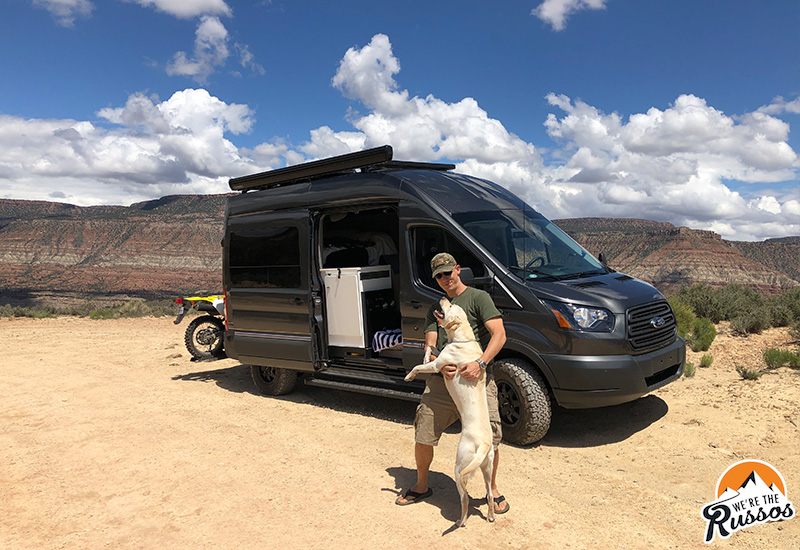Some of the links below are affiliate links, which means we will earn a commission on the products or services you purchase using the links. There is no additional cost to you and the earnings help keep this website running. Read the Affiliate Disclaimer for more information.
When Joe and I first began our RV adventure, we had two large dogs: Duke (a Belgian Malinois mix) and Leo (a white Siberian Husky). At over 70 pounds apiece, neither were exactly “travel-sized,” but we loved spending time with our dogs. In fact, they played a major role in our decision to travel full time in an RV in the first place. If you’re about to start RVing with dogs, this should help you get off on the right paw!
From shopping for the perfect rig to basic travel and RV safety tips, this post covers everything we wish we’d known before hitting the road in an RV with our dogs.
To learn more about our dogs and the RV shopping experience, check out Joe’s first book: Take Risks.
Full-Time RVing with Dogs
Watch this video for additional advice about how you can start RVing with your best (furry) friend.
Finding the Perfect RV (for your Dog)
Anyone who owns an RV will tell you that there are compromises made with any rig you buy. (So long, in-home washer and dryer!) We’re currently on our fourth camper, a Storyteller Overland Mode LT. Each one of those four RVs took us months of searching to find the right RV for us at the time. However, shopping for our first RV was the most difficult because we had to consider what needed in the RV and also what would work best for our dogs.
This was our list of must-have items for the RV with the dogs in mind.
1. Comfortable sleeping quarters with all the slides in
We knew we wanted our first RV to be a Class A motorhome so there would be times when we couldn’t put the slides out, like when we used overnight parking at a truck stop. “Comfortable sleeping quarters” for us meant that Joe and I could sleep in our bed and have enough room to lay both dog beds on the floor while the slides were in. This also meant a comfortable travel experience for Duke and Leo while we were on the road.
2. Room for the dog beds in the bedroom
Our dogs liked to be near us at night, so we knew we needed an RV with enough floor space in the bedroom for both large dog beds when the slides were out.
3. Easy access in and out of the RV
Back in 2015, Duke was having issues with his hind legs, and Leo was no great fan of stairs. The entrance had to be wide enough for us to walk alongside Duke to help him in but also allow Leo to run up without tripping (We used a dog harness to help us with Duke). While shopping, we were careful to note the number of steps to get in and out of the RV.
In contrast, when we got our pop-top truck camper, we no longer had a dog. If we’d had one, we would have had to lift them in and out of the camper since it was so high off the ground or continue to use the scissor steps, which we found dangerous without a handrail.
4. No floor to ceiling windows
Floor to ceiling windows offer a great view, but we had to put them on our list of features to avoid. Both dogs would have gladly taken out a window if it meant getting at a squirrel on the other side. Window coverings would have just been collateral damage.
5. Temperature control
Whether we’d be hooked up at a campground or boondocking in a National Forest, we wanted to make sure we had a good way to keep the RV cool for the dogs on hot days when we might be out exploring. That meant at least one AC unit and some kind of overhead fan.
When we switched to a Class B RV on the ProMaster chassis in 2017, we even had an electrical system that could support running the A/C off the batteries. It would automatically start the engine to recharge the battery if the AC ran the battery down too low while we were dry camping, which was a great safety feature to have. This was a game changer for us because inevitably there are times when you need to leave your dog(s) in the camper which you go into a store. Being able to put the A/C on for them on a toasty day made all the difference.
6. As little carpet as possible
Cleaning up after dogs is much easier on hard surface floors than on carpet. We won’t go into too much detail on the “why” behind this one … Just trust us or check out this fun facts video we put together about Leo our Siberian Husky.
RV Shopping Tip: Leave the Dogs at Home
We made the decision not to bring the dogs RV shopping with us, and we’re so glad we did. We didn’t want them to have a bad first experience in the rig we chose, especially since we couldn’t completely control the environment at a dealership or an RV show, and in an RV that was brand new to us.
For us, we wanted to be able to focus on the shopping experience, without being distracted by the dogs. And finally, it was just plain hot. For some reason, it always seemed to be in the 90s on days when we had time to shop for an RV.
That said, we did break our rule when we had Leo and were shopping for a Class B RV. We brought Leo to the RV show with us and when we got to the van, we figured we’d just take turns going in and out. Leo had other plans. He hoped right in and proceeded to crawl behind the driver’s seat and take a nap. This would turn out to be his favorite place in the van.
Introducing Your Dog to the RV
After we took delivery of our small Class A RV, we parked it in the driveway of our house, which we were getting ready to sell. Because we still lived in our “sticks and bricks,” we were able to introduce the dogs to the RV gradually and let them get comfortable before moving them in full time. We would highly recommend this approach, since it did take Duke and Leo some time to adjust to their new home on wheels.
Take your time
To prepare for the introduction, we put all the slides out and brought the dog beds, blankets, and water bowl into the RV. To our surprise, they both went up the stairs without any hesitation. We didn’t even have to lure them inside with treats.
Our dogs were unsure of their surroundings on their first few visits to the RV. We were patient and let them each find the spots they liked best. Duke, the protector, liked to station himself by the door. Leo hung out under the steering wheel. By the time we had completely moved into the RV, both dogs were very comfortable sleeping there, which made the transition easy – for them, at least. Read our post on the highs and lows of RV Living.
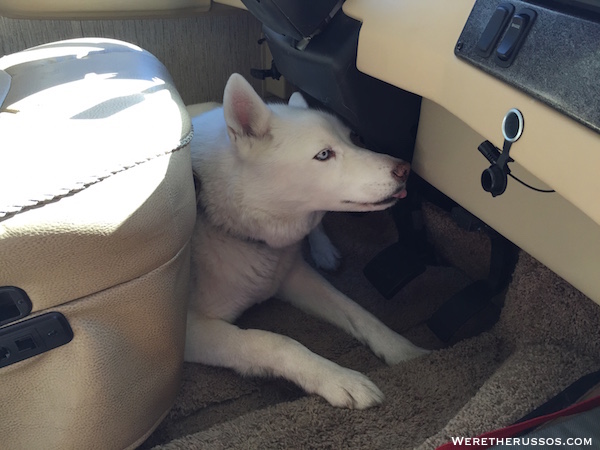
Taking the Dogs for a Drive in the RV
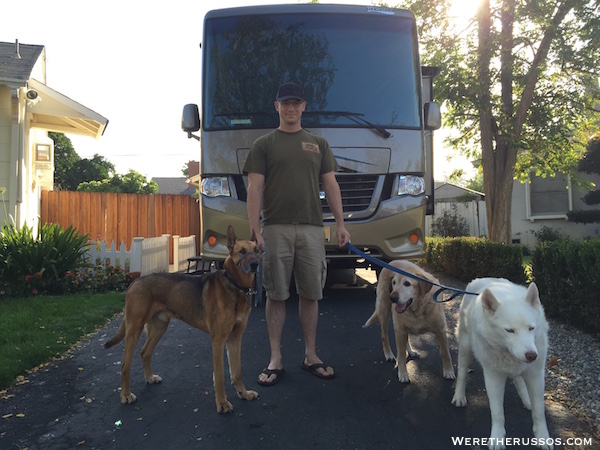
Go for a test drive
Both dogs loved riding in our Jeep Wrangler and had never been carsick, so we really didn’t think too much about their first ride in the RV. This turned out to be a big mistake.
The first time we went for a drive, Joe was by himself in the RV while I followed in the Jeep. (We didn’t have our ReadyBrute Elite Tow Bar installed yet.) Once Joe got going, noises in the moving RV scared both dogs. Leo tried to crawl under Joe’s legs to his spot under the steering wheel, while Duke tried to climb onto his lap. Not a good situation in a large moving vehicle! Luckily, Joe was able to pull over, and I took both dogs in the Jeep with me.
Instead, we’d suggest having someone in the RV with you that the dogs know who can help if they do freak out for any reason. Keep some treats on hand or have other things that distract them from everything else going on. Also, make sure EVERYTHING in the RV is secure. The last thing you need is a drawer flying open going around a corner (that happened to us) that scares the dog(s). We’d suggest putting together a comprehensive pre-departure checklist to prevent this from happening.
Tire the dogs out
We were better prepared the next time, when we went for a weekend beach camping trip in Ventura, California. This time we left the Jeep at home, so I was able to ride in the RV and make sure the dogs stayed calm and out of the driver’s seat. They were a little anxious on the drive out but much more relaxed on the way back, when they were worn out from the weekend at the beach. That’s when we realized we needed to exercise the dogs before we got on the road so they’d be too tired to mind the drive much.
Be patient
It took about a week of driving and living in the RV full time for the dogs to become completely comfortable riding around in their new home. Give your pets the time and space they need to adjust, and do what you can to make travel days comfortable.
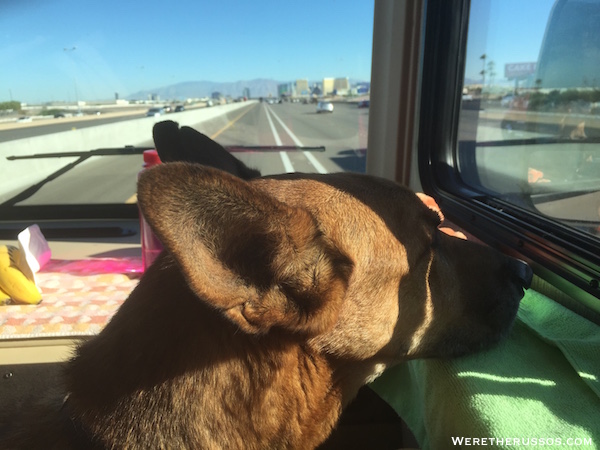
Duke’s favorite spot was at the feet of whomever was passenger. He would lay his head on the dashboard or the window ledge and just watch the road go by. Leo would lay on the bed by the entrance or hang out in his “taco shell”.
Home Alone – Leaving the Dogs in the RV
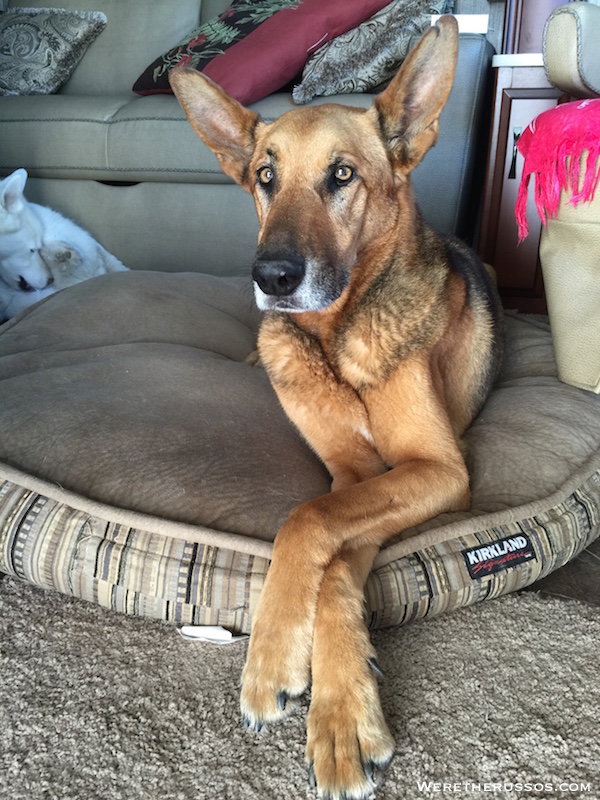
Start with short trips
The first time we left the dogs alone in the RV, it was only for 30 minutes. When they handled that fine, we started to leave them for longer and longer periods so they could adjust. We worked our way up to leaving Leo alone for up to five hours, as long as we prepared him with a long walk and made sure he’d taken care of all his business. (We lost Duke early in our travels due to health issues – more on losing a pet on the road below.)
Explore with them
Of course, we usually didn’t leave him this long, because we tried to take him with us just about everywhere. As a rule of thumb, if the businesses or town we were in wasn’t dog friendly, we’d keep on rolling. After all, we chose RVing as a lifestyle so we could bring our dogs!
Of course, there are exceptions to every rule, and we still made time to visit Disney World and go hiking in National Parks. On those rare occasions when we had to leave Leo, we would always check the weather forecast to decide if we needed to turn on the A/C or run the fans.
We would never leave our dog alone for an extended period in the RV unless we were at a campground with reliable electric hookups, so we could run the A/C as much as necessary. The campground could also contact us if an emergency arose.
Even so, a pet safety temperature monitor is a good idea as a backup, in case any systems fail. These monitors will send notifications to your phone if the temperature inside your rig gets too high.
Consider the neighbors
A word of caution to those with Class A’s or campers with large windows: We had some campground neighbors call security on us because they thought we’d left Leo in our RV without the A/C running.
A small sign in your door or window explaining the precautions you’ve taken can help notify your neighbors that you’ve taken the steps necessary to keep your pets safe.
Tips and Tricks – Having an Enjoyable RVing Experience with Dogs
Here are a few other things we learned as full time RVers and dog parents.
Go for long walks on travel days
On travel days, we would always take the dogs for a long walk. This way they got all their business taken care of, and were bit worn out before driving to boot.
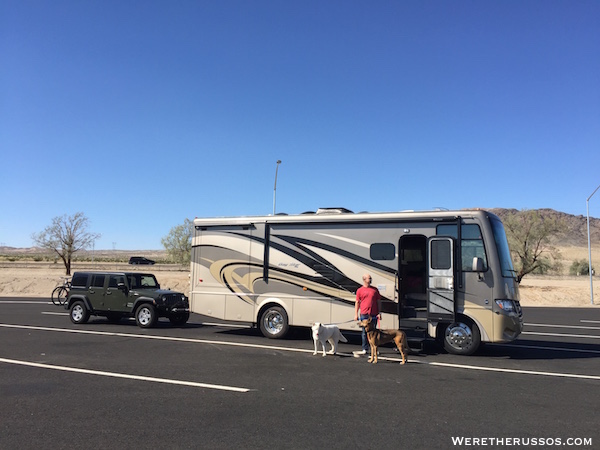
Leave some water in the dog bowl
The water bowl was always about halfway full before we got on the road. This way, the dogs could take a drink whenever they wanted, and we never had an issue with spills when going around corners. Or, you can try a no-spill dog bowl.
Be mindful of potty breaks
When we first started full time RVing, we drove long distances and relied on rest areas to walk the dogs. Eventually we slowed down and limited our travel to 100-150 miles at a time and found that we didn’t need to give Leo a break until we arrived at our destination. Travel days can get hectic; make sure you’re paying attention to your dog’s bathroom needs.
Vacuum daily
Did we mention that Leo was a white Siberian Husky? He would shed 365 days a year, so we vacuumed daily to keep the hair under control. Otherwise, it would start to look like it had “snowed” inside our RV. We used a handheld pet vacuum with an attachment that worked well on carpet. (Hopefully you won’t need to vacuum as much as we did!)
Finding a veterinarian
We’re lucky to have friends and family all over the United States that we can call on to ask for recommendations. Most of them are dog owners and have veterinarians that they use and trust. As our extended family of full time RVers grew, we could also call on them for recommendations. If you’re just getting started and don’t know anyone in the area, Google is a great resource because you can read reviews.
If you’re dog tends to need vets more regularly, it would help to research them before going into an area. It also helps to see if there are animal hospitals that offer emergency service.
Keep in mind that vets are licensed in the state in which they practice, and we’ve been told that getting a prescription filled across state lines can be tricky.
Losing a dog on the road
We lost Duke early in our travels due to health issues, and Leo passed away a few years later. Losing our boys was the most difficult thing we’ve experienced on the road. Finding a veterinarian in an unfamiliar city and trying to figure out what to do with the remains were things we just didn’t anticipate. Loss is always difficult, but dealing with loss on the road felt even more so.
If this ever happens to you, I would suggest taking some time off from the road. Maybe finding a campground you can hunker down for a bit or even getting an Airbnb. We felt a bit lost after losing Leo since we’d had dogs for so long and weren’t sure what to do with ourselves.
We’re lucky to have been able to share part of this journey with them and will always have wonderful memories to look back on.
Dog Products We Used and Loved
There are so many dog products we love for RVing. Here are a few that we found to be essential.
Sturdy Dog Harness
Whether you’re going hiking or have an older dog that needs a little assistance getting in and out of a vehicle, having a sturdy harness is essential for traveling. Read our Dog Harness Review.
Airtight Dog Food Container
This container is large enough to hold one 40-lb bag of dog food. In our Class A, we stored it in one of the bays. Be sure to measure the area where you plan to put yours to ensure it will fit.
RVing is a fantastic way to travel with your dogs. We can’t imagine doing it any other way! We hope you enjoy RVing with your dogs as much as we did.
If you have stories or photos from your own journey with your pets, please share them in the comments!

